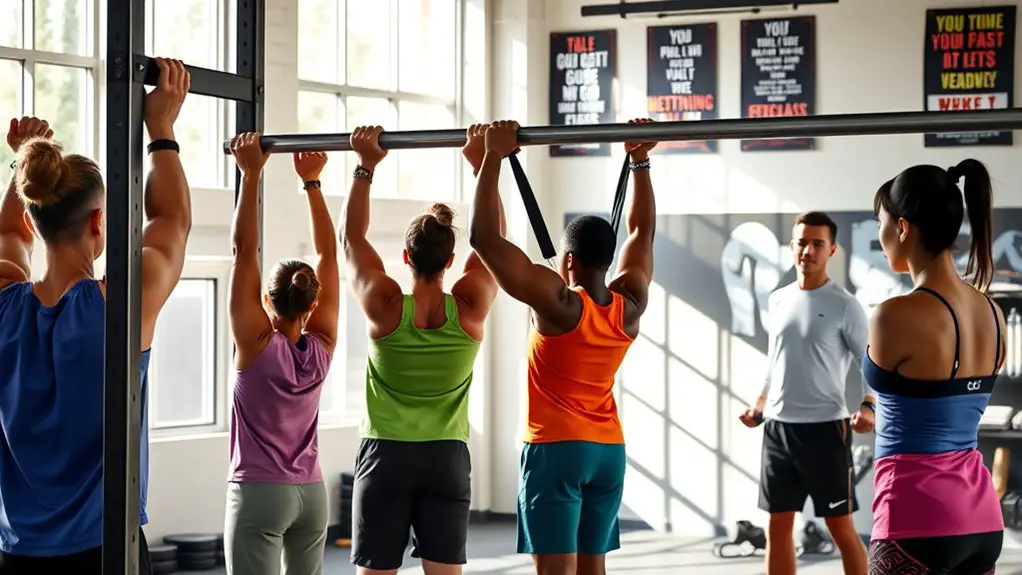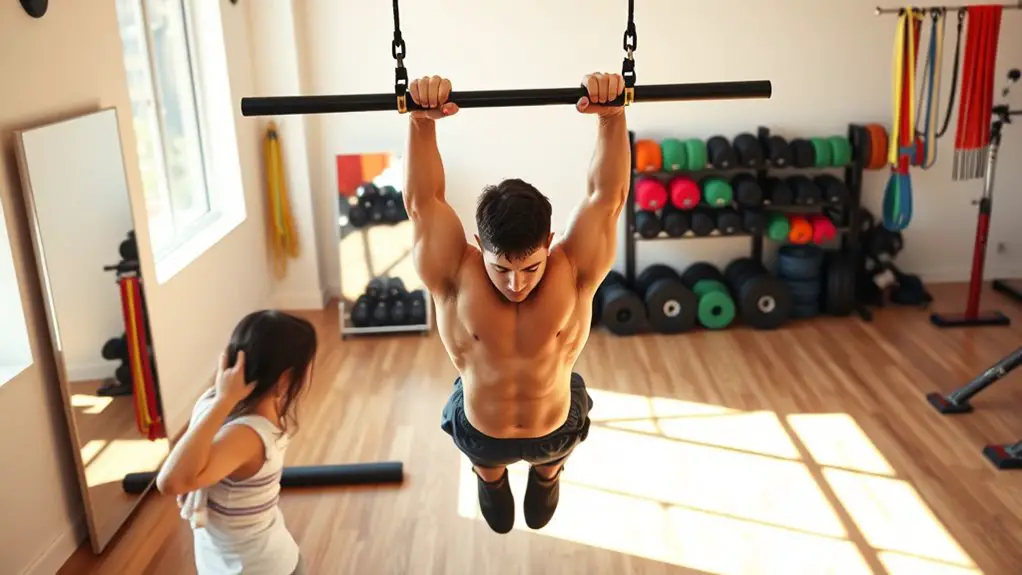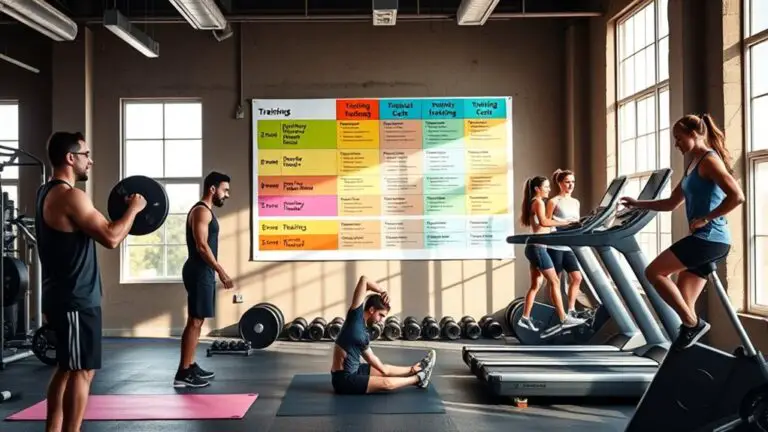The Best Gym Pull-Up Progressions for Beginners

To master pull-ups as a beginner, start by strengthening your grip with exercises like dead hangs and towel pull-ups. Incorporate assisted pull-ups using bands or machines to build confidence and form. Negative pull-ups help you develop eccentric strength by focusing on the lowering phase. Don’t forget scapular pull-ups and inverted rows as stepping stones. With consistency and commitment, you’ll progress toward a full pull-up. Keep going, and you’ll discover even more effective training techniques to enhance your journey!
Understanding the Pull-Up: Benefits and Basics

Pull-ups are a powerful exercise that can transform your upper body strength and enhance overall fitness. When you master pull-up mechanics, you engage multiple muscle groups, including your back, shoulders, and arms. This not only builds strength but also improves your posture and stability.
One of the most significant pull-up benefits is its ability to create a strong foundation for other exercises. As you progress, you’ll notice increased endurance and muscle definition, contributing to your overall athletic performance. Plus, pull-ups are fantastic for boosting your confidence; each rep completed serves as a reminder of your growing strength.
To get started, focus on proper form. Engage your core, keep your shoulders down, and pull your chin above the bar. Remember, consistency is key. With dedication, you’ll soon reap the rewards of this incredible exercise and feel empowered in your fitness journey.
Strengthening Your Grip: The Foundation for Success
Mastering pull-up mechanics is only part of the journey; a strong grip is equally important for your success. Without a solid grip, you’ll struggle to perform pull-ups effectively. Start incorporating grip exercises into your routine, such as dead hangs, where you simply hang from the bar, allowing your grip to strengthen over time. You can also try various grip variations, like wide or narrow grips, to challenge different muscle groups while enhancing your grip strength.
Consider using a towel draped over the bar to engage your forearms even more. This not only increases grip endurance but also prepares you for the demands of pull-ups. Remember, a strong grip is the foundation for lifting your body weight. As you build this strength, you’ll notice improvements in your overall performance and confidence. Keep pushing yourself, and soon, those pull-ups will feel much more achievable!
Assisted Pull-Ups: Using Bands or Machines

While achieving your first unassisted pull-up may seem intimidating, assisted pull-ups can be a game-changer on your journey. Utilizing band resistance or machine assistance allows you to build strength gradually while still engaging the muscles needed for the movement.
When using resistance bands, you can loop them over the pull-up bar and place your foot or knee in the band. This setup provides support, helping you lift your body weight more easily as you develop strength. On the other hand, pull-up machines offer adjustable assistance, allowing you to control how much weight you’re lifting.
Both methods enable you to practice your form and build confidence. Remember, consistency is key! As you progress, you can reduce the assistance from the bands or machine over time, pushing you closer to that coveted unassisted pull-up. Keep challenging yourself; you’ve got this!
Negative Pull-Ups: Building Eccentric Strength
Build your strength with negative pull-ups, a powerful technique for developing eccentric muscle control. These negative reps focus on the lowering phase of the pull-up, allowing you to build strength effectively, even if you can’t perform a full pull-up yet.
Here’s how to incorporate negative pull-ups into your routine:
| Step | Description |
|---|---|
| Start Position | Jump or step up to the bar |
| Lower Slowly | Control your descent for 3-5 seconds |
| Repeat | Aim for 3-5 sets of 3-5 reps |
| Rest | Take adequate breaks between sets |
Scapular Pull-Ups: Engaging the Right Muscles

Scapular pull-ups are a game-changer for activating the right muscles and setting a solid foundation for your pull-up journey. By focusing on proper form, you’ll not only enhance muscle engagement but also prevent injuries down the line. Let’s explore some progression tips to help you master this essential movement!
Muscle Activation Techniques
Mastering the art of pull-ups hinges on effective muscle activation, and scapular pull-ups are a fantastic way to engage the right muscles early on. By focusing on muscle recruitment through these activation strategies, you’ll build a solid foundation for your pull-up journey. Here’s how to get the most out of scapular pull-ups:
- Keep your arms straight while hanging from the bar.
- Initiate the movement by squeezing your shoulder blades down and together.
- Hold the contraction for a second at the top.
- Slowly release back to the starting position.
- Repeat to enhance stability and strength.
Incorporating scapular pull-ups into your routine will not only improve your muscle activation but also set you up for success in mastering traditional pull-ups!
Proper Form Essentials
Achieving proper form in scapular pull-ups is essential for engaging the right muscles and maximizing your strength gains. Start by hanging from the bar with your arms fully extended, ensuring you maintain proper body alignment. Your shoulders should be slightly retracted, allowing your scapulae to engage. As you begin the movement, focus on pulling your shoulder blades down and together, rather than bending your elbows. This will activate your back muscles effectively. Don’t forget to keep your core engaged throughout; this stabilizes your body, helping to prevent swinging and promoting a controlled movement. Remember, mastering scapular pull-ups with the right form lays a solid foundation for your pull-up journey. Stay focused, and trust the process!
Progression Tips Explained
Once you’ve nailed the proper form for scapular pull-ups, it’s time to focus on progression tips that will help you engage the right muscles effectively. These tips will enhance your strength training and prepare you for various pull-up variations:
- Start with Dead Hangs: Hang from the bar to activate your shoulders.
- Practice Scapular Shrugs: Pull your shoulder blades down and together without bending your elbows.
- Incorporate Isometric Holds: Hold the top position for a few seconds to build stability.
- Add Resistance Bands: Use bands for assistance while maintaining proper form.
- Gradually Increase Reps: Challenge yourself to do more reps as you get stronger.
Stay consistent, and you’ll see significant progress in your pull-up journey!
Inverted Rows: A Step Towards Full Pull-Ups

Inverted rows are a fantastic way to bridge the gap between basic strength training and full pull-ups. They target your back, biceps, and core, making them an ideal progression. Start with a basic inverted row and adjust your body position for varying difficulty. If you’re finding it too easy, try elevating your feet or using a wider grip—these inverted row variations challenge your muscles further.
To maximize your results, focus on form. Keep your body straight and engage your core throughout the movement. As you get stronger, slowly increase the number of reps or sets you perform. Remember, it’s all about consistent practice and gradual improvements.
Incorporating inverted rows into your routine not only builds the strength you need for full pull-ups but also boosts your confidence. Keep pushing yourself, and you’ll be well on your way to conquering that first pull-up!
Mastering the Full Pull-Up: Tips for Success
To master the full pull-up, you need to focus on a few key areas: grip strength, controlled eccentric movement, and assisted techniques. Building your grip strength is essential for holding your body weight, while mastering the descent helps improve overall control. Don’t hesitate to incorporate assistance to build confidence and eventually conquer that full pull-up!
Grip Strength Development
Grip strength is the foundation of a successful pull-up, and developing it can greatly enhance your overall performance. To build that strength, incorporate specific grip exercises and utilize grip tools into your routine. Here are some effective ways to boost your grip:
- Dead Hangs: Simply hang from a pull-up bar to strengthen your grip.
- Farmer’s Walk: Carry heavy weights in each hand to challenge your grip endurance.
- Towel Pull-Ups: Wrap a towel over the bar and perform pull-ups to engage your grip muscles.
- Plate Pinches: Hold weight plates together with your fingers to improve grip strength.
- Grip Trainers: Use specialized tools designed to enhance your grip.
Stay consistent, and you’ll notice significant improvements in your pull-up performance!
Controlled Eccentric Movement
Mastering the full pull-up isn’t just about the upward movement; it’s equally important to focus on the controlled eccentric phase. Eccentric training, where you lower yourself slowly from the bar, builds strength and muscle control essential for a successful pull-up. As you lower, aim to extend your arms and engage your back muscles gradually. This not only enhances your strength but also helps prevent injury by promoting proper form. Focus on maintaining tension throughout the descent, resisting gravity without dropping too quickly. Incorporating this phase into your routine will lead to noticeable improvements in your pull-up performance. So, embrace the challenge of eccentric movement, and watch as your pull-up game strengthens considerably!
Assisted Pull-Up Techniques
While building strength for unassisted pull-ups can be challenging, incorporating assisted pull-up techniques into your routine can make a significant difference. These methods help you build confidence and strength progressively. Here are some effective assisted variations you can try:
- Assisted Pull-Up Machine: Use the machine to offset your weight, allowing you to focus on the movement.
- Resistance Bands: Loop a resistance band around the bar and place your knees or feet inside for support.
- Negative Pull-Ups: Jump to the top position and slowly lower yourself down, focusing on control.
- Partner-Assisted Pull-Ups: Have a friend support your legs while you pull up.
- Isometric Holds: Hold yourself at the top position for as long as possible to build endurance.
These techniques will set you on the path to mastering unassisted pull-ups!
Frequently Asked Questions
How Often Should I Practice Pull-Up Progressions Each Week?
When it comes to practicing pull-up progressions, frequency guidelines suggest aiming for about 2 to 3 times a week. This allows your muscles to recover while still making progress. Integrate these sessions into your weekly routine, giving yourself a rest day in between to maximize gains. Remember, consistency is key, and with dedication, you’ll see improvement. Keep pushing yourself, and soon enough, those pull-ups will feel easier than ever!
Can I Do Pull-Up Progressions if I Have Shoulder Injuries?
Imagine your shoulder as a delicate flower, needing care to bloom again. If you’ve got shoulder injuries, it’s essential to prioritize rehabilitation strategies. Before diving into pull-up progressions, focus on improving shoulder mobility through gentle exercises. Listen to your body and consult a professional to guarantee you’re on the right path. With patience and proper guidance, you can nurture your strength back and eventually tackle those pull-ups with confidence.
What Equipment Do I Need for Pull-Up Progressions at Home?
If you’re looking to do pull-up progressions at home, you’ll need some essential equipment. A sturdy pull-up bar is a must, whether it’s a doorframe bar or a freestanding one. Resistance bands can also be really helpful for assisted pull-ups. If you’ve got a set of dumbbells, they can enhance your workout too. With the right equipment, you’ll be well on your way to mastering those pull-ups and achieving your fitness goals!
How Long Will It Take to Achieve My First Pull-Up?
Achieving your first pull-up can feel like climbing a mountain, but with dedication, you’ll reach that peak. Depending on your current strength and commitment to pull-up techniques, it might take anywhere from a few weeks to a few months. Focus on incremental strength milestones, and stay consistent with your training. Celebrate small victories along the way, and remember, each rep brings you closer to that exhilarating moment of completing your first pull-up!
Are There Alternative Exercises for Building Pull-Up Strength?
Absolutely, there are great alternatives for building pull-up strength! Start with scapular pull-ups; they’ll help you engage your shoulder muscles effectively. Just hang from the bar and focus on retracting your shoulder blades. You can also use a resistance band to assist you. Loop it around the bar and place your foot in it, which can help you practice the movement with less body weight. Keep pushing, and you’ll get there!





